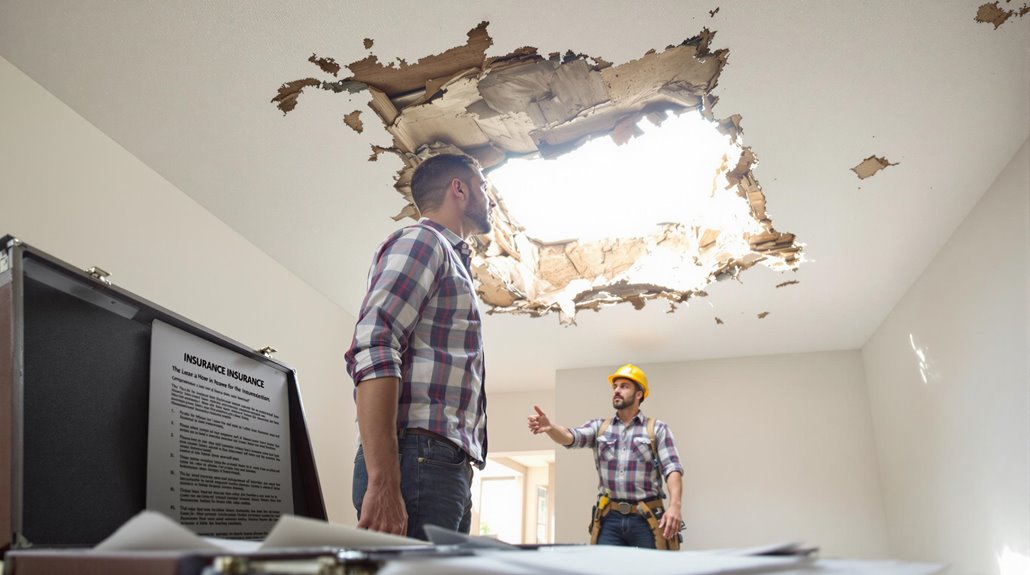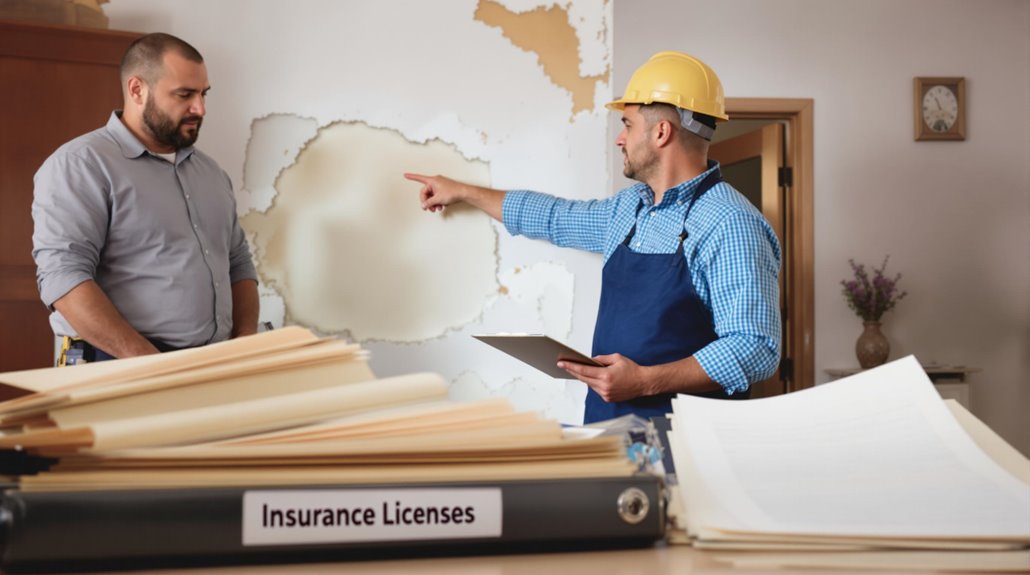If a contractor damages a property, the homeowner should conduct a thorough assessment of the damage and gather evidence to establish liability and support a potential claim. This involves documenting damage through photographs and written notes, as well as notifying the contractor and establishing open communication. Understanding contractor liability and insurance is also essential. Taking these initial steps will provide a solid foundation for seeking compensation and resolving disputes, a process that can be more fully explored.
Key Takeaways
- Conduct a thorough assessment to determine the extent of damage and identify specific damage types, such as structural issues or broken items.
- Notify the contractor as soon as damage is discovered and provide clear expectations for resolving the damage issue.
- Gather photographic and written evidence, including notes and contractor conversations, to compile into a detailed report for potential claims.
- Review contractor agreements to assess liability types and determine responsibility for damages, including professional and property damage liability.
- Consider hiring a public adjuster to enhance the potential for higher claim payouts and navigate the claim filing process efficiently.
Assessing the Damage and Gathering Evidence
When a contractor has damaged a property, the first essential step for the property owner is to conduct a thorough assessment of the damage to determine the extent of the issue. This involves identifying specific damage, such as broken items or structural issues, and determining the cause of the damage to establish liability.
A detailed damage assessment also considers the impact on the overall project or property value. To support the assessment, it is imperative to gather photographic evidence, including clear and detailed photos of the damage from multiple angles, as well as written evidence, such as detailed notes and records of conversations with the contractor.
Effective evidence organization is also essential, compiling all documentation into a detailed report and ensuring consistency in formatting and organization. This thorough approach enables property owners to accurately document the damage and establish a strong foundation for potential claims. Working with public adjusters can increase settlement amounts by 30-50% when filing insurance claims for contractor-caused property damage.
Notifying the Contractor and Establishing Communication

Following a thorough assessment of the damage and gathering of evidence, the property owner's next step is to notify the contractor and establish open lines of communication. This notification process should be done as soon as possible after discovering the damage to prevent further complications.
Effective communication strategies involve providing clear expectations for resolving the situation, documenting conversations, and ensuring all parties are informed. The property owner should ask the contractor to confirm receipt of the notification and their plan for addressing the issue.
Establishing open communication helps to promote contractor accountability and facilitates a smoother resolution process. The contractor's response will indicate their willingness to take responsibility for the damage and provide insight into their plan for resolving the issue.
Understanding Contractor Liability and Insurance

While traversing the complexities of property damage caused by a contractor, understanding the nuances of contractor liability and insurance is vital for property owners seeking compensation. Contractors have a duty of care to perform work with the same level of skill and care as a reasonable contractor in their field. Liability can include damages caused by faulty plumbing, roofing, foundations, electrical work, and structural damage. Claims adjuster investigations typically require 30-60 days to determine liability and appropriate settlement amounts for contractor-caused damages.
| Type of Liability | Description |
|---|---|
| Professional Liability | Faulty workmanship, design errors, or omissions |
| Public Liability | Damage to third-party properties or persons |
| Property Damage Liability | Damage to the property being worked on |
| Environmental Liability | Spills, improper disposal of materials, or other environmental harm |
A thorough damage assessment is essential in establishing contractor negligence. Property owners should review their contractor agreement to guarantee it includes provisions for taking responsibility for any damage caused.
Seeking Compensation for Damages and Losses

Provided that a thorough assessment of the damage has been conducted and evidence has been documented, property owners can proceed to seek compensation for damages and losses incurred as a result of a contractor's negligence or breach of duty.
A meticulous evidence evaluation is essential in establishing the extent of the damage and determining the contractor's liability. Compensation strategies may involve notifying the contractor, contacting the insurance company, or pursuing small claims court.
Property owners may employ various methods for calculating damages, such as the Total Cost, Modified Total Cost, Jury Verdict, Quantum Meruit, or Delta Estimate methods.
The chosen method depends on the specific circumstances of the case and the available documentation. Effective compensation strategies require a thorough understanding of the contractor's insurance coverage, policy terms, and applicable laws.
Engaging a public adjuster early in the process can lead to settlements up to 800% higher than handling the claim independently.
Preventing Future Damage and Resolving Disputes

In order to mitigate the risk of future damage and effectively resolve disputes, property owners must adopt a proactive approach when engaging contractors.
Implementing risk management strategies, such as selecting insured contractors and verifying their licenses and bonding status, can considerably reduce the likelihood of damage. Conducting regular inspections and reviewing contracts carefully are also essential steps in identifying potential risks and minimizing liability.
If disputes arise, employing conflict resolution techniques can help resolve issues efficiently and effectively. Approaching disputes calmly, communicating clearly, and specifying desired outcomes can facilitate mutually beneficial agreements.
By incorporating dispute resolution procedures into contracts, property owners can also prevent future disputes. By combining these proactive measures with regular follow-up and open communication, property owners can guarantee a successful partnership with contractors and mitigate the risk of damage to their property.
Working with licensed public adjusters who maintain valid licenses and clear background checks can provide additional protection when dealing with contractor-related property damage claims.
Effective risk management and conflict resolution are critical to a successful contractor-property owner relationship.
The Benefits Of Consulting A Public Adjuster

When a contractor damages property, consulting a public adjuster can provide invaluable benefits in maneuvering the complex insurance claims process.
Public adjusters bring expertise in insurance claims, providing an objective damage assessment that enables a streamlined claim process, ultimately resulting in higher claim payouts and settlements.
Unlike insurance company adjusters who focus on minimizing claim payouts, public adjusters work independently to advocate for the policyholder's best interests.
Expertise In Insurance Claims
As steering through the complexities of insurance claims can be overwhelming for property owners dealing with damage inflicted by contractors, consulting a public adjuster is often a wise decision due to their extensive expertise in this area.
Public adjusters possess in-depth knowledge of insurance policies, enabling them to conduct thorough insurance policy analysis to identify the maximum coverage available. They employ effective claim negotiation strategies to secure higher settlement amounts.
Their professional expertise in handling insurance claims allows them to navigate the complex process, ensuring policyholders receive the maximum settlement. By leveraging their expertise, property owners can alleviate stress and focus on resolving the property damage inflicted by contractors, while public adjusters handle the intricacies of the insurance claim.
Working on a contingency fee basis, public adjusters typically charge between 5-20% of the final claim amount, making their services accessible without requiring upfront payments.
Objective Damage Assessment
Objective damage assessment is a critical component of the insurance claim process, particularly when a contractor has damaged a property. A public adjuster can provide an unbiased assessment of property damage, utilizing various tools and techniques to identify damage indicators. Studies show that public adjuster involvement typically increases settlement amounts by 20-50% compared to unrepresented claims. The benefits of consulting a public adjuster for objective damage assessment include:
| Benefits | Methods | Outcomes |
|---|---|---|
| Thorough documentation | Moisture meters, infrared | Detailed records |
| Independent representation | Collaboration with experts | Unbiased assessments |
| Specialized knowledge and equipment | Drones for aerial inspections | Accurate claims |
Streamlined Claim Process
The importance of objective damage assessment is matched by the need for an efficient claim process, which can be facilitated by consulting a public adjuster.
A public adjuster's expertise in claim handling enables them to organize and manage claims efficiently, minimizing time spent on claim process issues and reducing stress related to paperwork and negotiations.
This streamlined approach guarantees timely and legally compliant claim presentation, exploring all applicable coverages under the insurance policy. By leveraging their knowledge of insurance policies and claim procedures, public adjusters can expedite claim efficiency, providing transparent and timely updates on claim status.
Effective communication and negotiation skills also enable public adjusters to advocate for the insured's interests throughout the claim process.
Licensed professionals conduct thorough property damage assessments to determine accurate repair or replacement needs.
Higher Claim Payouts & Settlements
Consulting a public adjuster can greatly enhance the potential for higher claim payouts and settlements in cases where a contractor has damaged a property.
Public adjusters possess expertise in property damage assessment, enabling them to conduct thorough evaluations and prepare accurate documentation of damages. This extensive approach guarantees that all losses, including hidden damages, are identified and accounted for in the claim.
Effective claim negotiation with insurance companies is also a key benefit of working with a public adjuster. By leveraging their knowledge of insurance policies and procedures, public adjusters can maximize settlements and protect policyholder interests.
The result is often increased settlements and minimized out-of-pocket expenses for policyholders. Accurate damage documentation and skilled claim negotiation are essential components of a successful claims process.
Studies show that property damage settlements typically increase 30-50% when working with a public adjuster to handle the claim.
About The Public Claims Adjusters Network (PCAN)

When maneuvering the complex process of filing a claim for property damage, policyholders often find themselves at a disadvantage, lacking the expertise and resources to effectively negotiate with insurance companies. The Public Claims Adjusters Network (PCAN) provides a valuable resource to level the playing field. PCAN members maintain harmonious professional relationships while assisting fellow adjusters and sharing technical expertise to better serve clients.
| Public Adjuster Services | Claims Negotiation Strategies | Policyholder Benefits |
|---|---|---|
| Damage assessment, policy interpretation, and negotiation | Expertise in insurance policies and procedures | Higher claim payouts, often 300-400% more than initial offers |
| Extensive claim handling and support | Utilizing public adjuster advantages to maximize claims | No upfront fees, stress reduction, and efficiency in the claims process |
| Reviewing and interpreting insurance policies | Conducting thorough assessments of property damage | Access to a national network of public adjusters, covering all 50 states and internationally |
References
- https://attorneysre.com/how-to-handle-damage-caused-by-a-contractor/
- https://lscarlsonlaw.com/articles/can-you-sue-contractor-property-damage-guide
- https://www.avnergat.com/contractor-damages-property/
- https://www.acquisition.gov/far/52.247-21
- https://schorr-law.com/contractor-damages-property-in-california/
- https://www.hsecontractors.com/blog/common-methods-for-assessing-construction-damages-2/
- https://www.dicklawfirm.com/blog/2024/june/what-to-do-if-a-contractor-damages-your-property/
- https://www.fema.gov/sites/default/files/documents/fema_pa-ida-checklist_05-18-21.pdf.pdf
- https://www.insuranceclaimrecoverysupport.com/assess-the-damages/
- https://saffwein.com/how-to-handle-property-damage-claims-for-damage-caused-by-a-contractor-in-doylestown/








